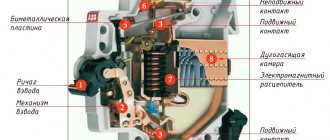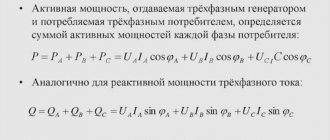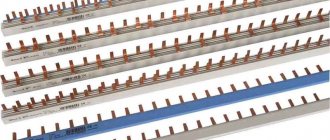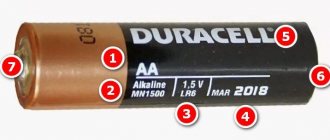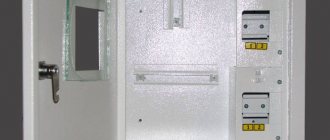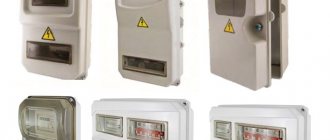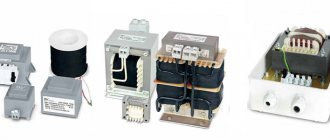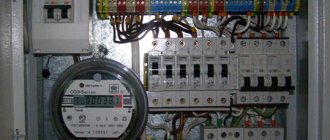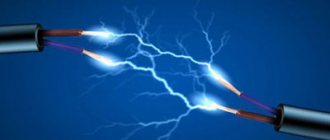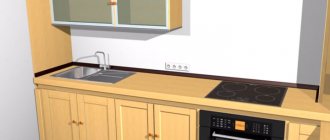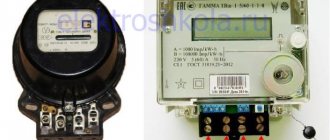Now are the times when the value of human life has become the main priority, and at the same time there are excesses - many restrictions and innovations are justified by safety. Today we will talk again about electrical safety, which is provided by a home electrical panel, through the prism of knowledge about short circuit current. Yes, this is not the first time I have raised this topic. But don’t rush to close the website! The topic concerns everyone - after all, it is a security topic! Spoiler: I will prove that panels equipped with machines with characteristic “B” are much more preferable for our houses and apartments.
In recent years, some restrictions and innovations have been introduced in the electrical engineering field, which serve primarily two purposes - preserving human life and preserving the life of equipment (from general to specific - electrical networks, electrical installations, loads). Fortunately, modern technologies and devices make it possible to ensure the safety of both people and wires.
Here is a partial list of the protections in our electrical panels that I am talking about:
- Automatic switches (AB), which turn off the power during overloads and short circuits. This is the only device in our electrical panels, the installation of which is strictly required in any case.
- Residual current devices (RCDs), or in the new-fashioned way, residual current switches (RCCBs), which turn off the power when a dangerous value of differential current appears (its appearance means that a dangerous and even fatal potential for humans may arise on the housings of the devices). This also includes RCBOs (automatic residual current switches), which are hybrids of AV and RCCBs.
- Voltage relays that turn off the power and thus protect equipment from overvoltage and undervoltage;
- Arc flash protection devices (AFDs) or anti-sparking devices (AFDs), which turn off the power if any kind of spark is suspected, even at low current.
- Surge protection devices (SPDs) or surge limiters (OSLs), which stop, to the best of their ability, powerful short-term voltage surges that can be caused by natural or man-made causes. Depending on the circuit configuration, the power in this case is also usually turned off.
On the one hand, people have become richer, and now many can afford electronic “things” that previously could only be dreamed of. On the other hand, these “things” have become more accessible in price and availability.
Some people say that this is “swindling the client out of money,” but I don’t agree with that. If the client values his life, is ready to pay for it, and understands what it is and why, then all possible protections must be put in place.
It is important that the installation of any protection must be justified, and its characteristics must be carefully calculated. After all, no protection, even the most necessary one, should be unnecessarily complex and ruin your nerves due to false positives.
Among illiterate electricians there is such a criterion for choosing a machine - “So as not to knock it out.”
In the article we will talk about how to most effectively protect electrical appliances and electrical wiring from short circuits (short circuits). This is done thanks to an innovation that enters our lives with great difficulty, despite the penny costs. The reason for this is the inertia of the Russian mentality, its ignorance and fears. Which I will dispel in this article.
For completeness, I recommend that you read my previous articles on this topic - “Short-circuit current: size matters” and “Selectivity in a home panel: how to achieve the impossible.”
First, as usual, a little background information.
Take care of the cable, Sanya!
On the issue of restrictions, it is worth mentioning that the requirements for the thermal conditions of cables have become more stringent. Although I don’t remember changes in regulatory and technical documentation (NTD) that could have caused this to happen. But I perfectly remember the surprised and indignant eyes of the senior electrician Ivanovich at one of my first objects, when he told me: “What 16? All my life the sockets were set to 25 amps! Don't be smart! And now putting 16 A on socket lines with a copper cross-section of 2.5 mm2 is the norm.
I think this happened for two reasons:
- Previously, half an apartment could hang on one 25 A circuit breaker, which meant several sockets, plus several incandescent light bulbs. This was due to poverty - this way you can save on wires and on machines, of which there were usually two or three per apartment. In this case, the current on the line was relatively large, and with a rating of 16 A there would be relatively frequent outages due to overload. Therefore, we found such a compromise. Now on one 16 A machine there are usually a maximum of three sockets “hanging”, and the lighting is connected separately.
- More attention has been paid to the survivability and reliability of the cable. The main thing that determines its service life is the operating temperature. More precisely, the boundaries of temperature differences and their frequency. The more frequent and greater the changes (the more often and more the core heats up), the faster the insulation dries and loses resistance, and the faster the contacts at the joints deteriorate. The main factor influencing the heating of the core is current. Hence the logical conclusion - by limiting the current, we limit possible heating and increase the service life of the cable. In this sense, it turns out that to protect a cable with a cross-section of 2.5 mm2, a machine with a rating of 16 A has priority over 20 A, and even more so 25 A.
The permissible heating temperature of the cable cores for most cables is 70 °C. For more details, see GOST 31996-2012. The cross-sections and resistances of current-carrying conductors are described in GOST 22483-2012.
In addition, the new standards (SP 256.1325800.2016, amendment 3 of 2019, table 15.3) say that the cable of the socket group cannot have a cross-section of less than 2.5 mm2. That is, there is no way to save on cable now, even if a refrigerator with a power of 200 W “hangs” on this line, and the rating of the machine is 6 A. If the line to the sockets is laid with a cable with aluminum conductors, its cross-section must be at least 4 mm2.
Aluminum cable is changing its properties and may soon officially appear in our homes. Read about this in the previous issue of the magazine.
Using cable as an example, we can say that the operating modes of many electrical network components have become more gentle, and the components themselves are better protected.
Unacceptable mistakes when purchasing
There are several mistakes that novice electricians can make when choosing a circuit breaker based on current strength and load. If you choose an automatic protective device incorrectly, even slightly missing the rating, this can lead to many unfavorable consequences: the circuit breaker will trip when the electrical appliance is turned on, the electrical wiring will not withstand current loads, the service life of the circuit breaker will be quickly reduced, etc.
To prevent this from happening, we recommend that you familiarize yourself with the following errors, which will allow you to choose the right circuit breaker for your home or apartment in the future:
The first and most important thing you should know is that when concluding a contract, new subscribers order the energy capacity of their connection. From this, the technical department makes calculations and selects where the connection will take place and whether the equipment, lines, TP can withstand the load
Also, based on the declared power, the cable cross-section and the rating of the circuit breaker are calculated. For residential subscribers, an unauthorized increase in the input load without upgrading it is unacceptable, since the power has already been declared according to the project and the supply cable has already been laid. In general, the nominal value of the introductory machine is chosen not by you, but by the technical department. If you end up choosing a larger circuit breaker, everything must line up. Always focus not on the power of household appliances, but on the electrical wiring. You should not select a machine only based on the characteristics of electrical appliances if the wiring is old. The danger is that if, for example, to protect an electric stove you choose a 32A model, and the cross-section of the old aluminum cable can only withstand a current of 10A, then your wiring will not withstand it and will quickly melt, which will cause a short circuit in the network. If you need to choose a powerful switching device for protection, first of all replace the electrical wiring in the apartment with a new, more powerful one. If, for example, when calculating the appropriate rating of the machine for the operating current, you came up with an average value between two characteristics - 13.9A (not 10 or 16A), give preference to the larger value only if you know that the wiring will withstand the current load 16A. For a dacha and a garage, it is better to choose a more powerful circuit breaker, because a welding machine, a powerful submersible pump, an asynchronous motor, etc. can be used here. It is better to provide for the connection of powerful consumers in advance, so as not to overpay later on the purchase of a switching device of a higher rating. As a rule, 40A is quite enough to protect the line in domestic use. It is advisable to select all automation from one, high-quality manufacturer. In this case, the likelihood of any discrepancy is minimized. Buy products only in specialized stores, or even better, from an official distributor. In this case, you are unlikely to choose a fake and, moreover, the cost of products from a direct supplier is, as a rule, slightly lower than from intermediaries.
That’s the whole method for choosing the right machine for your own home, apartment or cottage! We hope that now you know how to choose a circuit breaker based on current, load and other equally important characteristics, as well as what mistakes should not be made when purchasing!
How to choose the right rating of the switching device for your home or apartment?
{SOURCE}
Short circuit protection
The most important point in this matter is that with such a formidable phenomenon as a short circuit, the eyes of all the inhabitants of the apartment are hopefully turned to the electromagnetic release, which is an integral part of every modern circuit breaker. It is he who saves all participants in the electrical circuit - from the short circuit to the AB terminals.
What guarantees can the machine provide us in the event of a short circuit? To answer this question, it is fundamentally important to know the ratio of the short-circuit current and the “nominal” of the electromagnetic (EM) release (current multiplicity). The main and only condition for turning off the circuit in such incidents is that the operating current of the EM release in any case must be less than the expected short-circuit current.
Otherwise, the thermal release will have to take over, but it works reluctantly, lazily - unlike its electromagnetic partner. As a result, in a few agonizing seconds, until the thermal release gives the command to open, something irreparable can happen. For example, the twist of aluminum and copper that a young tiler made when he moved an outlet in the bathroom will burn out.
Knowing the expected short-circuit current and the release characteristic (in the case of a home panel it is “B” or “C”), we can say for sure whether the machine will be able to save the situation in the event of a short circuit (we talked about this in other articles). But in most cases, we know the short-circuit current only approximately - after all, it can change unpredictably due to many factors. What to do?
My answer is this. We play it safe with the cable by lowering the expected current (limiting it) using the rated current AB. But it is not always possible to lower the rating of the machine - it is limited by the rated current consumed by the load. This means that you need to lower the “rating” of the EM release. But this must be done wisely - so as to ensure circuit breakage at extremely low short-circuit currents, while at the same time not limiting the load in any way. Logical reinsurance?
In other words, you need to “lower the letter” of the electromagnetic release from “C” to “B” in order to get more shutdown guarantees during a short circuit. How to do this, ensuring maximum protection, and at the same time eliminating false positives? The answer will be in this article.
Representatives of circuit breakers of families “B” and “C” with a rated current of 10 A
Features of operation of network protection circuit breakers
Whatever class the circuit breaker belongs to, its main task is always the same - to quickly detect the occurrence of excessive current and de-energize the network before the cable and devices connected to the line are damaged.
Currents that may pose a danger to the network are divided into two types:
- Overload currents. Their appearance most often occurs due to the inclusion of devices in the network, the total power of which exceeds what the line can withstand. Another cause of overload is a malfunction of one or more devices.
- Overcurrents caused by short circuit. A short circuit occurs when the phase and neutral conductors are connected to each other. In normal condition they are connected to the load separately.
The design and principle of operation of the circuit breaker is on video:
https://youtube.com/watch?v=9bTw3wtgOWY
Overload currents
Their value most often slightly exceeds the rating of the machine, so the passage of such an electric current through the circuit, if it does not drag on for too long, does not cause damage to the line. In this case, instantaneous de-energization is not required in this case; moreover, the electron flow often quickly returns to normal. Each AV is designed for a certain excess of electric current at which it is triggered.
A thermal release, the basis of which is a bimetallic plate, is responsible for turning off the power under the influence of a powerful load.
This element heats up under the influence of a powerful current, becomes plastic, bends and triggers the machine.
Short circuit currents
The flow of electrons caused by a short circuit significantly exceeds the rating of the protective device, causing the latter to immediately trip, cutting off the power. An electromagnetic release, which is a solenoid with a core, is responsible for detecting a short circuit and immediate response of the device. The latter, under the influence of overcurrent, instantly affects the circuit breaker, causing it to trip. This process takes a split second.
However, there is one caveat. Sometimes the overload current can also be very large, but not caused by a short circuit. How is the device supposed to determine the difference between them?
In the video about the selectivity of circuit breakers:
Here we smoothly move on to the main issue that our material is devoted to. There are, as we have already said, several classes of AB, differing in time-current characteristics. The most common of them, which are used in household electrical networks, are devices of classes B, C and D. Circuit breakers belonging to category A are much less common. They are the most sensitive and are used to protect high-precision devices.
These devices differ from each other in terms of instantaneous tripping current. Its value is determined by the multiple of the current passing through the circuit to the rating of the machine.
Differences between characteristics “B” and “C”
Why do we need different protective characteristics of machines? At first glance, the differences are insignificant - only in the thresholds for turning off the electromagnetic release. At the same time, thermal releases with the same rated current do not differ. What's the difference?
Let's take for comparison two circuit breakers with the same rated current of 10 A. Do you see the difference?
Time-current characteristics of automatic circuit breakers with instantaneous trip type “B” and “C” with a rated current of 10 A
Let's take a closer look at the time-current characteristics (TTC) of these two copies (data can be taken from the manufacturer's catalog or from GOST IEC 60898-1-2020):
At VTX “B” (on the left), the electromagnetic release is switched off (opens the contacts), starting from an overcurrent of 3...5 times more than the rated one. This means that in this case the machine can turn off at an overcurrent of more than 30 A. A should turn off at currents of 50 A and above.
VTX “C” (on the right) differs only in the current from which it can and should turn off - 50 and 100 A, respectively.
The opening time of the electromagnetic release, which means disconnecting the circuit due to a short circuit, must be less than 0.1 s. This is what is shown in both graphs. The actual shutdown time of the AV during a short circuit is an order of magnitude less (about 0.01 s), and this is only a plus. After all, during half a voltage period in the event of a short circuit, it is unlikely that anything will be damaged or catch fire. Figuratively speaking, the EM release is the weakest link in the chain, which is intended to live up to the proverb “Where it is thin, it breaks.”
IIITOIIOP68 › Blog › Slot machines - what's what and why.
Good day!
Today we will look at circuit breakers
A little theory. Why are they even needed? But they are needed precisely to protect the network and devices only from short circuits and overloads. They do not perform any other protective functions. Circuit breakers (hereinafter referred to as AB) have several characteristics
Trip curve - B, C, D
The tripping curve is the short circuit rating required for tripping. The graph clearly shows that the shutdown curve B is 3-5 ratings, C is 5-10 ratings, D is 10-20 ratings. What are these curves for? Shutdown curve B - used in new buildings and in houses where there is low voltage. If the C16 circuit breaker needs at least 80 amperes to disconnect due to a short circuit, then B is only 48 amperes. Therefore, if the wiring is old or weak, or the voltage is low, then the best option is a machine with curve B. Shutdown curve C - used everywhere from domestic to industrial use. The most common curve. There is basically nothing to describe here: 5-10 denominations are the norm. Shutdown curve D - is mainly used for reactive loads - devices containing a winding (motors, large groups of lamps with chokes, etc.). With such a curve, machines are installed in access distribution boards. If a machine with curve C and a rating of 16 amperes needs 80 amperes for short-circuit shutdown, then the same machine with curve D needs 160 amperes for short-circuit.
This is how we came to the term AV selectivity. The selectivity of circuit breakers is the selection of devices in one system in such a way that in the event of damage or an emergency in any part of the electrical system, the shutdown is carried out by one circuit breaker, which is located closest to the point of damage on the line and other circuit breakers do not worked. That is, if a malfunction or accident occurs in the area of the socket, then only the circuit breaker of the socket group of this room is turned off, and the machines located between the meter and this machine are not turned off.
2. The AV also has a maximum short-circuit breaking current - this is the maximum current at which the circuit breaker’s breaking capacity will be maintained. It is designated by the numbers 4500, 6000 or 4.5 kA, 6 kA, and so on. If our machine has a maximum breaking capacity of 4500 A = 4.5 kA, then a short-circuit current of 4500 amperes will most likely ruin it. But at home or in an apartment it is practically impossible to obtain such a current through a short circuit. Therefore, there is no point in setting more than 4.5 kA for houses and apartments. For offices, non-residential premises and in production, 6kA circuit breakers are used in full - there are reactive loads and short circuits are possible.
3. And there is also a bimetallic plate. It is needed to turn off the AV when overloaded. Let's say: there is a 16-amp circuit breaker, a maximum power of 3520 Watts, the rating of the thermal release along curve C is on average 1.45 of the rating - 23.2 amperes or 5104 Watts! But this does not mean that you need to overload the line by 1.45 times! If there is such an overload, the machine will work almost immediately! But if you start from 4000 Watts, then there will be a delay of 5-10 minutes. after which the AB will work.
4.They also differ in modules. 1 module = 17.5 mm - German DIN standard. Consequently, machines come in 1, 2, 3 and 4 modular types.
THERE ARE NO 2- and 3-PHASE AUTOMATIC MACHINES!
Now let's look at the machine itself in analysis
These are the guts of a Chinese machine gun! The numbers indicate its main components: 1. Connection terminal (located both above and below the AB) 2. Arc chamber - necessary for dividing a large arc (during short-circuit tripping) into smaller arcs that will not damage the AB. 3. Bimetallic plate. 4. Electromagnetic release. 5. Switch mechanism.
Well, now let’s look at AVs from different manufacturers. They are sorted by quality from good to bad.
1. ABB S200 - purebred Germans! A professional series with high quality, the price tag is high, but worth it. There have not yet been any complaints that these machines did not work. 6kA. This series has the ability to connect all sorts of additional accessories. equipment relay max/min voltage, status contact and others. A separate compartment has been made for connecting the comb/fork bus.
2. ABB SH200 - also purebred Germans. The series for the home is already 4.5 kA. More simple, but the highest quality.
3. Schneider Electric Acti-9 series iC9 or iK9 - German French. The quality is slightly lower than ABB, but still there. iС9 and iК9 differ in the same thing - a professional and simple series.
4. Legrand DX-3 and DX-3 are French, assembled in Poland or Bulgaria (oh whore!), the quality is correspondingly lower. The price tag is mainly for the brand. DX-3 is a professional Polish series, TX-3 is a simple Bulgarian series.
5. Schneider Electric Domovoy - a budget series from Schneider. Collected in Romania, the quality is slightly lower than Legrand. The price is also lower.
6. KEAZ - OptiDin - Kursk! Our! The quality, according to the manufacturer, is high, but not tested. Assembled by hand, defect rate is 0.1%. the price tag is acceptable.
7. IEK - a fucking persecution of Chinese assembled in Russia - I personally saw how they burn! Very beautiful))) The machines were stolen from Schneider (when they were still Merlin Gerin) about 15-20 years ago. They are still produced using the same technology (Schneider has long surpassed them in technology and quality). Suitable for temporary work (so that builders/finishers/renovators don’t steal it too late) and for budget organizations. But recently, oddly enough, the quality has begun to improve.
8. TDM - separated from IEK and created their own factory with blackjack and whores! The drawings, technologies and all the bells and whistles are the same, only TDM! The quality is below IEKa.
9. There are also all sorts of ASD, EKF, DeKraft and others, whose quality is very questionable. Also copied from the ancient developments of Merlin Gerin, but clumsily and without modifications, because of this they often burn and have a short service life.
Why does the machine trigger?
Let me remind you that we are considering only an electromagnetic release, which includes the concepts “B” and “C”. It can be triggered by overcurrent in two cases:
- short circuit;
- high starting current.
The machine does not care how the supercurrent was formed. But let's not be automatic, and consider each option in more detail.
Short circuit
How to determine why the machine turned off - due to overload or due to a short circuit (short circuit)?
Overload shutdown usually refers to any overcurrent that causes the thermal release to activate. And turning off the machine due to a short circuit can be considered the case when such an overcurrent flowed through the machine that it activated the electromagnetic release.
Why is it so important that the machine turns off during a short circuit as early as possible? Short circuit current is, in fact, the maximum overload that can occur in a given section of the circuit. But the short circuit current is not infinite - it is determined by the resistance of the circuit from the substation to the point of the fault.
If the resistance of the wires and the contact resistance of the contacts is high (and in the private sector this is quite often the case!), the current during a short circuit somewhere in the carrier can be only 100 A. If the smallest circuit breaker is set to 25 A with the type of protective characteristic “C” ", electromagnetic protection will work (depending on your luck!) at a current of 125 to 250 A. That is, it will not work at all! A thermal release will help out, but its reaction time can be from 2 to 10 s. And during this time, anything can catch fire from sparks and flames from the ill-fated carrier.
Starting current
The current at which the electromagnetic release is triggered can, in practice, not only result from a short circuit. A short-term excess of current several times can occur when starting various inertial devices. This current is called starting current.
As a rule, the starting current of an electrical appliance exceeds the rated current, sometimes several times. Numerically, the starting (Iп) and rated (Iн) currents are connected through the starting current multiplicity coefficient Kп: Iп=Iн×Кп, where Кп >1 .
The inrush current differs from the overload current in that it has a very short duration of action (from 0.01 to 0.1 s), during which the thermal release will definitely not have time to operate. During this time, only the EM release can respond to it. Some sources indicate the duration of the inrush current to be several seconds. But the authors are disingenuous - at the end of this time the current can hardly be called starting, because it is almost equal to the rated one.
Inrush currents are highest for loads with electric motors, as well as for devices that have noise filter capacitors and electrolytic capacitors in their power supplies, and this is almost all electronic equipment, from LED light bulbs to personal computers.
Inrush current is the main argument of opponents of installing machines with instantaneous tripping type (characteristic) “B”. Do you want to talk about it? Please!
How to choose a machine?
Let's take a classic example. We are making repairs in an apartment (or in a private house), changing the electrical wiring and want to protect it from overloads and short circuits. A common practice these days is to divide the wiring into several branches and protect each of them with a separate machine. In apartments, lighting and sockets are often separated into separate lines. In addition, a separate line can be allocated for an electric stove, another for kitchen sockets and utility room sockets, which usually include the most powerful electrical appliances in the apartment: electric kettle, microwave oven, washing machine, etc. It should be noted that standard electrical outlets used in our homes are usually designed for a maximum current of 10 or 16A, and are often the weakest link in the electrical wiring. Therefore, the rating of the circuit breaker protecting the line with such sockets cannot be higher than 16A, no matter how thick the wire is.
About the material and thickness of the wire - this is a separate topic, here I will just say briefly: copper and only copper, for apartments and private houses we take a cross-section of 1.5 sq. mm for lighting, 2.5 sq. mm for standard sockets. Accordingly, the ratings of circuit breakers for lighting lines are 10A, for lines feeding sockets, 16A (provided that the sockets are also 16-amp). This raises a number of questions. It turns out that each socket can withstand 16 Amps alone, but the total current of the entire group of sockets should also not exceed the same 16 Amps.
Some people don’t like this situation, and they install machines with a higher current - 25A and even higher. For some reasons, this should not be done, even if the cross-section of the wire will allow such current to pass for a long time. Let's imagine a situation where some powerful power tool is plugged into one of the sockets, which consumes current up to 25-30A. It is clear that with such a current, unpleasant processes can occur in the outlet, including fire, but a 25-amp circuit breaker will not feel this overload. Well, or he will feel it, but only when everything is already burning with a blue flame. Someone may argue that there is no standard power tool with such a current consumption, but the tool can be non-standard and faulty. Or it may happen that several powerful electrical appliances are connected to the outlet at the same time through an extension cord, with the same result.
Therefore, if it is assumed that the total current of the equipment simultaneously plugged into the sockets will be more than 16A, then the correct solution would be to divide the sockets into several groups and power each group through a separate circuit breaker. It must be borne in mind that both 16 and 10 amp outlets are available for sale. I won’t say that those rated at 10A are of poor quality - they are simply designed for a maximum load current of 10 A. For such sockets, it is permissible to lay wiring with a cross-section of 1.5 mm2, but the circuit breaker in this case must also be 10-amp. Regarding extension cords. Very often you can find cheap options, the cross-section of the cord of such an extension cord is 1 mm2, sometimes even smaller. Extension cords themselves usually do not have any protection.
Therefore, use such extension cords with extreme caution, understanding that the machine may not protect them.
What should I do to prevent the machine from turning off due to the starting current?
With a circuit breaker, like with any protective device, the essence of the job is to fully provide protection, but at the same time minimize the likelihood of false operation. Since inrush currents - large or small - are always present, you must first determine what they are numerically equal to. I have compiled a table showing the actual starting currents of various household devices.
Table of inrush currents for various household loads
For the table, I took loads with power greater than average and gave approximate starting currents. Let's analyze it.
Incandescent lamp
They have a significant inrush current due to the physical properties of the tungsten helix - in a cold state its resistance is much lower than in a hot state. But what do the numbers in the table mean? Let's imagine that we have a five-arm chandelier with a total power of incandescent lamps of 500 W, which turn on simultaneously. The starting current will reach 25 A. Is this a lot? According to PUE-7 (Table 7.1.1) and SP 256.1325800.2016 (Table 15.3), the minimum cross-section of copper conductors must be 1.5 mm2. To reliably protect such a cable, you need an AV with a rating of no more than 10 A. If you install an AV with characteristic “B”, it can turn off at inrush currents of more than 30 A. Is AV “C” needed here? No.
LED bulbs
These also include LED spotlights. These lighting sources are designed in such a way that when turned on, the driver consumes a huge current. Manufacturers try to make the start-up of such lamps smoother, but the compromise between the starting current and the efficiency of the LED lamp is usually selected at the value Kp = 50...150. The low rated current of LED lamps saves the situation.
If you need to turn on many of these lamps at once, you have to resort to tricks and preliminary calculations based on data from the manufacturer. Here are some ways to reduce the inrush current when turning on a large number of LED lamps:
- Divide into groups that turn on through one machine, but at different times.
- Divide into groups that turn on at the same time, but from different machines.
- Use devices that reduce the starting current at the moment of switching on. For example, inrush current limiting relay MRP.
All the loads that I consider below are connected to socket lines with a minimum cable cross-section of 2.5 mm2. This means, despite Ivanovich’s categorical opinion, we set the maximum machine to 16 A.
Fridge
Despite the engine, it has a relatively small starting current, which even in the worst case scenario will not exceed 10 A.
Electronics
As I already said, due to the input capacitors, it has a large inrush current. However, this fact is offset by the fact that most modern electronics operate in standby mode (Standby) when power is applied. In this mode, the consumption is much lower than the nominal value. To reduce the negative, you need to do the same as with LED lighting - turn on different devices at different times in different sockets , which are powered by different machines.
Submersible pump
This point also includes other equipment where the working element is fixed directly to the motor shaft. These devices have the highest inrush current. But what do the numbers say? Even a relatively powerful 500 W pump at startup consumes a current of no more than 16 A. This means that we can not only install a machine with characteristic “B”, but also lower its rating to 10 or even 6 A! This will have a beneficial effect on the protection of the pump - there is a greater chance that the machine will turn off the power when the impeller gets jammed (I was recently told that a rat got stuck in the pump). Please also note that the pump is often powered through a cable tens of meters long.
Washing machine and air conditioner
These large household appliances rarely consume electrical power greater than 2000 W. But even with such power, their starting current is small, since the electric motor accounts for only part of the consumption - they are not powered directly, but through soft start circuits.
Meat grinder, food processor, vacuum cleaner
They also have an electric motor that draws significant starting current. But this current will be greatest only in extreme cases - when turned on at maximum speed in devices without a gearbox. Only then will the starting current with a small probability be a justification for abandoning characteristic “B” in favor of “C”.
How to calculate the rating of a circuit breaker?
Let's assume that we took into account all of the above and selected a new cable that meets modern requirements and has the required cross-section. Now the electrical wiring is guaranteed to withstand the load from switched on household appliances, even if there are quite a lot of them. Now we proceed directly to the selection of a circuit breaker based on current rating. Let's remember the school physics course and determine the calculated load current by substituting the corresponding values into the formula: I=P/U.
To simplify the selection of a circuit breaker and save you from the need to use a calculator, we present a table that shows the ratings of the circuit breakers that are included in single-phase and three-phase networks and the corresponding total load power.
This table will make it easy to determine how many kilowatts of load correspond to which rated current of the protective device. As we can see, a 25 Ampere circuit breaker in a network with a single-phase connection and a voltage of 220 V corresponds to a power of 5.5 kW, for a 32 Ampere circuit breaker in a similar network - 7.0 kW (this value is highlighted in red in the table). At the same time, for an electrical network with a three-phase delta connection and a rated voltage of 380 V, a 10 Amp circuit breaker corresponds to a total load power of 11.4 kW.
Visually about the selection of circuit breakers in the video:
Inrush currents are reduced
Most manufacturers are aware of the harm and dangers that inrush current brings. Here's what they do to reduce it:
- An NTC thermistor (thermistor) is installed at the power input of electronic devices, which, due to its physical properties, has a high resistance in a cold state. Of course, this is not a panacea, and there are restrictions on their use associated with a decrease in the efficiency of the device as a whole.
- Inverter power supply for soft start. By this I mean powering the motors through semiconductor starters. Frequency converters, soft starters and the proud inscription Invertor are from this opera.
- Delayed power supply via relay. In this case, at the beginning, part of the power is supplied, and after a split second - 100%. I wrote about this above and gave the example of the MRP relay.
- An increase in cos φ and a decrease in harmonics and the reactive component of the supply current also contribute to the overall cause.
Fortunately, inrush currents, unlike rated currents, in most cases do not act simultaneously. If you turn on the power in an apartment, it is better not to do it through the main (input) switch. The rule of good manners is to supply power sequentially, turning on group machines one after another.
What does the NTD say?
There is no direct regulatory and technical document prohibiting, obliging or limiting the use of machines with characteristic “B”. Everything is based on measurements and calculations. If the “phase-zero” loop (short-circuit current) allows, then you can set any characteristic (“B”, “C”, “D”).
More precisely, characteristic “D” is not approved for use in residential premises. GOST 32395-2020 “Distribution panels for residential buildings” (as well as its earlier version from 2013) speaks only about the shutdown characteristics “B” and “C”. Characteristic “D” is not used in everyday life also because it is simply meaningless - there are not and cannot be large starting currents that exceed the rated current by 10...20 times.
Characteristic “D” is mentioned (and therefore allowed) only in GOST 32397-2020 “Distribution panels for industrial and public buildings”.
By the way, using “B” in group lines, the easiest way is to expand the selectivity zone in the home panel and increase the reliability of the home energy system.
Also in PUE-7 (clause 1.7.79, 7.1.72) there is a requirement for circuit breakers - if the short circuit current does not ensure that the circuit breaker is turned off in 0.4 seconds, then the installation of an RCD is required. If you don’t want to install an RCD, select the machines according to their nominal value and characteristics. In fact, this is a requirement that during a short circuit it is the EM release that is triggered. After all, only he can provide such a shutdown time.
For example: the short-circuit current in the socket network is 100 A. The C16 machine will not work (16×10×1.1=176 A). What can be done:
- Install a machine with a lower rating to the detriment of power. But in this case, even C10 is a stretch: 10×10×1.1=110 A.
- Increase the cable cross-section. In this case, instead of 2.5, lay 4 mm2. I think there is no need to explain how difficult this can be to implement in practice. And it is not a fact that this event will lead to the desired result.
- Install automatic machine B16 (16×5×1.1=88 A). Bingo!
Types of protective devices
There are several types of AVs that are connected to the network in order to monitor the condition of the wiring and, if necessary, stop the current supply. They may be as follows:
- Mini models (small in size).
- Air (open type).
- Residual current devices (abbreviated name - RCD).
- Closed (device elements are housed in a molded housing).
- Differential (circuit breakers combined with RCD).
Mini models
These devices are designed to operate in circuits where the load is low. They usually do not have additional adjustment functions. This series includes devices that can withstand a misfire current of 4.5 - 15A. They are not suitable for factory power, since the current strength in enterprises is much higher than their nominal value. Therefore, they are usually connected to household wiring.
The machines included in the product line of the French company Schneider Electric are very popular. The ratings of the AVs produced by this company can be 2 - 125A, so you can choose a package for home lines of various powers.
Air (open) devices
If the total power of the devices connected to the network is large, and the ratings of the machines mentioned above are insufficient, air protective devices should be chosen. The rated cut-off current of open-type bags is an order of magnitude higher than that of mini-models. Most often they are three-pole, but recently many companies have started producing four-pole machines.
Open type protective devices should be installed in distribution cabinets equipped with special DIN rails on the inside.
If the cabinet's protection class is IP55, then it can be placed outside the building. The body of this equipment is made of refractory metal and is reliably protected from moisture penetration, which ensures a high level of safety for the machines located inside it.
Airborne ABs have a great advantage over miniature ones. It lies in the ability to customize their nominal characteristics using special inserts that are placed on the active contact.
Enclosed circuit breakers
The body of these devices is cast from refractory metal, which ensures their perfect tightness and makes them suitable for use in harsh conditions. The maximum voltage that such machines can withstand is 750V, and the current is 200A. Closed AVs are classified according to the type of action into the following groups:
- Adjustable.
- Thermal.
- Electromagnetic.
The optimal type should be selected based on the tasks being solved.
The highest accuracy is achieved by electromagnetic closed circuit breakers, which determine with a minimum error the root mean square indicator of the active electric current and instantly de-energize the network in the event of a short circuit, avoiding serious consequences.
Electromagnetic machines are successfully used to control the functioning of motors in factory machines, as well as other powerful equipment, since they can withstand currents of up to 70 kA. The number indicating the current rating of the circuit breaker is printed on its body.
All types of enclosed switches can have two to four poles. Thanks to this, they can be used to protect electrical networks of any residential and non-residential buildings and structures.
Residual current devices
Residual current devices should not be used as independent protective devices, since their main task is to protect people from sudden electric shock. Therefore, it is recommended to install them together with the automatic circuit breaker, or to purchase a differential circuit breaker that already includes an RCD. In the first case, you need to take into account that the residual current device should be installed first, and then the circuit breakers.
If you change the installation order, a short circuit will lead to failure of the RCD as a result of too high a load.
When will which machine turn off?
For convenience, I have compiled a table of the shutdown currents of the most common ratings in everyday life, characteristics “B” and “C”:
Table of short-circuit shutdown currents for AVs of different ratings and shutdown characteristics
There are two ways to use this table - based on the existing circuit breaker or based on the measured short-circuit current. For example, a C16 circuit breaker with an overcurrent of 80 A (5In) will turn off slowly and only due to thermal tripping. And at 160 A (10In) it will turn off instantly (less than 0.1 s), which is what is required during a short circuit.
And finally, let's talk about an extremely important point for everyone.
Price
Opponents of “B” machines argue that the price of electrical panels can skyrocket. And you won’t find such devices for sale. Their fears are easily dashed by facts. Here is a comparison table for machines “B” and “C” of two brands of opposite quality (according to information from a well-known online store):
Comparison of prices of machines “B” and “C”
Does a 5-10% price difference really matter?
Not available? I don’t know about you, but in my province the necessary modular equipment is available in a wide range.
Current limiting class
Let's move on. An electromagnetic release, although called instantaneous, also has a certain response time, which reflects such a parameter as the limitation class. It is indicated by one number and for many models this number can be found on the device body. Basically, machines with current limiting class 3 are now produced - this means that from the time the current reaches the trigger value until the circuit is completely broken, no more than 1/3 of the half-cycle will pass. With our standard frequency of 50 Hertz, this turns out to be about 3.3 milliseconds. Class 2 corresponds to a value of 1/2 (about 5 ms). According to some sources, the absence of marking of this parameter is equivalent to class 1. The highest class that I came across is 4th for OptiDin machines manufactured by KEAZ.
What about them?
According to unconfirmed information, in technologically developed countries, “B” machines have long been installed by default. To put a “C”, you need a calculation justification. Look at the photo that a friend from Germany sent me:
Photo of the shield sent from Germany by Alexander’s friend
Approximately such shields are installed there in budget apartments. Input switching and RCD - on the landing.
I hope I have proven or given food for thought that it is advisable to install circuit breakers with characteristic “B” on the line of sockets and lighting. After all, their installation in household panels at the same amperage as “C” in most cases leads to a significant increase in electrical and fire safety. I am sure that the time will come when this priority will be spelled out in Russian regulatory and technical documentation.
